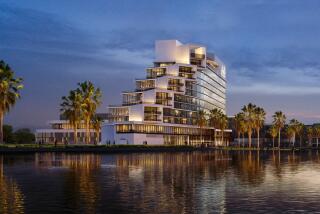There’s a commercial building boom going on across the Pacific, and local architects and builders are finding that their stars are also . . . : Rising in the East
- Share via
California designers are shaping Asia’s skylines, and nowhere is this more evident than in Jakarta, where Los Angeles-based Altoon & Porter Architects has just opened a $500-million mega-project that would dwarf familiar local venues such as Universal City’s Universal Studios/CityWalk. The 7.7-million-square-foot Taman Anggrek development includes a glitzy six-story mall and eight high-rise condominium towers.
But anyone hoping to get a piece of this action now is probably too late. The shopping mall, which includes an upper-level ice skating rink and Mercedes-Benz and Toyota showrooms, is already 97% leased, and all 2,900 condos have been sold.
The success of this project reflects the go-go growth occurring in countries such as Indonesia, the world’s fourth-most-populous nation, whose relatively young population and rapidly expanding economy have created an unquenchable thirst for the good life.
The Asian middle class--expected to be 500 million strong within the next five years--is creating a huge appetite for Western-style housing, consumer goods and leisure activities. And it is America’s designers, builders and real estate developers, particularly those from California, who are leading the charge.
One reason is the California lifestyle, which to many wealthy Asians represents the best of America. And in parts of Southeast Asia, the climate lends itself to the casual, outdoor-oriented building designs favored by Southern Californians.
The Hollywood mystique, particularly attractive to Asia’s youth, has created a large demand for expertise in entertainment projects such as multiplex theaters, theme parks and theme restaurants.
One challenge for designers in Asia is to meld Western expertise and local culture. Ronald Altoon, the architect in charge of the Taman Anggrek project, said its contemporary design--the base building looks like a vertical park with terraced landscaping and waterfalls--was inspired by the orchid gardens that once flourished in the surrounding areas.
Altoon pointed out that in Indonesia, shopping is a three-generation family experience. Grandparents, parents and children visit a mall together, and that requires much broader walking spaces and larger food courts.
“We believe that the cultural elements that shape people’s lives create the context within which Asian or American shopping centers succeed or fail,” Altoon said. Altoon is also the author of a new book, “International Shopping Center Architecture.”
Shop Till You Drop
As one of the world’s largest shopping center architectural firms, RTKL has enjoyed a leading role in the promotion of capitalism. The Los Angeles office of the international firm is taking this expertise to China, where its projects include a tourist village near the Hunangshan Mountains and the Sun Dong An Plaza, a $300-million mixed-use center in the heart of Beijing to be completed early next year.
The plaza, built on the site of an old market, will be one of the largest retail centers in China. The two seven-story atrium courts will feature restaurants and a food court, movie theater, bowling alley and nightclub.
Because the project is so close to Beijing’s ancient Forbidden City, RTKL took care to incorporate elements of classical Chinese architecture, such as the building facades and roof designs, and incorporate them with contemporary building materials.
The underground parking garage is designed to accommodate more than 5,000 bicycles--and just 400 cars.
Times staff writer Evelyn Iritani can be reached via e-mail at evelyn.iritani@latimes.com or by fax at (213) 237-7837.
Tomorrow: Health Care
More to Read
Inside the business of entertainment
The Wide Shot brings you news, analysis and insights on everything from streaming wars to production — and what it all means for the future.
You may occasionally receive promotional content from the Los Angeles Times.










